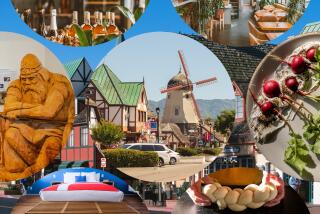Modern Swedish Town Evokes History’s Charm
- Share via
JAKRIBORG, Sweden — Standing on the cobblestone square of this southern Swedish town, you can almost hear the clopping of hoofs, the clinking of swords in scabbards and the creaking of carriages along medieval streets that wind past half-timbered homes and beneath stone archways.
Except none of that happened here. Until five years ago, this ancient-looking town didn’t exist.
Jakriborg was built from scratch in 1999 on a 25-acre tract of farm fields, a damaged greenhouse and an abandoned cement plant lying just west of Lund -- one of the oldest cities in Scandinavia, tracing its founding to A.D. 990.
In sharp rebuke to the sprawling apartment complexes that mushroomed across Sweden in a government-financed construction boom of the 1960s and ‘70s, Jakriborg’s developers turned to the past for something many think is missing in the modern Scandinavian welfare state: human warmth and medieval charm.
“In 1992, when no one was building, we were offered the chance to buy this land and had the idea that we would build in the old style,” said Jan Berggren, 58, who created Jakriborg with his brother, Kristian, 54. The town’s name consists of the first letters of their names and the Swedish word for castle -- borg.
“There will be a few towers and it’s going to be a bit like a castle, so why not call it Jakriborg?” Berggren said.
He said he always thought that it was “super-boring” the way buildings were erected during the construction boom. “You drew one building, then you produced another 100 identical ones.”
Indeed, a stroll through most Swedish towns finds vast expanses of apartment buildings that, aside from a different shade of orange or yellow, look the same, whether it’s Kiruna in the north or Goteborg on the southwestern coast.
“It’s sad when everyone walks into exactly the same door and climbs exactly the same stairs.... We want to feel like humans, like we are special,” Berggren said.
Jakriborg, which has blossomed into a village of about 1,000 people, although it is still officially part of the sleepy row-house town of Hjaerup, draws inspiration from the traditional architecture of southern Sweden, Denmark and northern Germany.
“The thought is that people built their own homes in those days. That’s why everything looks different,” Berggren said.
It’s not completely clear what “those days” means, and Berggren acknowledges that he isn’t aiming for a specific era. The architecture looks medieval, but the lampposts are 1890s London.
Critics say the town has the artificial feel of Disneyland, with houses a bit too symmetrical, streets too straight and cobblestones too polished.
“It feels like a dishonest environment.... Maybe it’s symptomatic for the lack of the sense of history that characterizes our time,” architect Agneta Hahne said.
Residents don’t seem to mind.
“When you come home, it feels like you’re in a fairy tale,” said Gunilla Neumeister, who shares a three-room apartment with her husband. “Deep inside, I think everyone feels they want to live a bit cozier.”
About 300 apartments are rented, and another 100 will be ready this year. In 15 years, Berggren expects about 7,000 people to live in 3,500 apartments. At a later stage, it will also be possible to buy apartments.
Rent -- a two-bedroom flat of 861 square feet goes for about $900 a month -- is comparable to the cost of similar-sized apartments throughout Sweden.
All the Jakriborg buildings are either half-timbered or colored brick, with steep, pointed roofs and gables facing the street. But each is slightly different: the color, the angle of the roof, the number of window panes, or the size and shape of the doors.
An old-style, brick-colored city wall is going up too -- not to protect residents against would-be raiders from Denmark, but from traffic and train noise.
The apartment units themselves are conventional, with parquet floors, tiled bathrooms, modern amenities and high-speed Internet connections.
The Berggrens, who as developers have jurisdiction over who moves in, have turned down several requests from businesses they believe would not blend with Jakriborg’s medieval atmosphere.
“We want a cozy street level, boutiques, cafes, restaurants and small shops, hairdressers and shoemakers. Like it was when we grew up. It should be pleasant to look in through the windows,” Berggren said.
Associated Press writer Karl Ritter contributed to this report.
More to Read
Sign up for Essential California
The most important California stories and recommendations in your inbox every morning.
You may occasionally receive promotional content from the Los Angeles Times.







